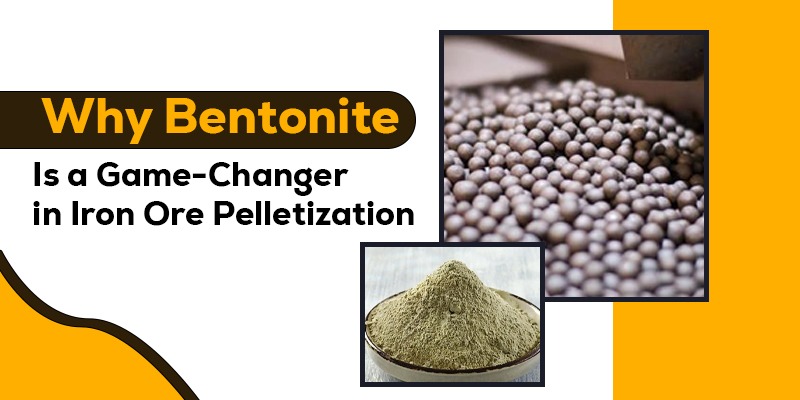
Why Bentonite Is a Game-Changer in Iron Ore Pelletization
In the metallurgy world, where big fires and factory-like accuracy are king, it is easy to miss out on the quiet players—especially when they are clay! However, bentonite has definitely changed the game in the tightly controlled universe of iron ore pelletizing. Bentonite's role is not particularly glamorous; however, it is indispensable.
This blog will highlight how bentonite has become synonymous with the iron ore path to strong steel, from pellet strength to environmental performance. Bentonite is changing the building blocks for modern steelmaking quietly but also profoundly.
Let’s Get Started: What is Iron Ore Pelletizing?
It is worth addressing what pelletizing is before talking about bentonite, since it is a crucial part of the conversation. Iron ore is typically found in nature either as fine particles or dust. The dust is unsuitable for making iron in any sort of blast furnace; its permeability will be poor and it has a tendency to blow away.
Pelletizing takes the dust and makes it into round and uniform pellets. Once made into pellets, they are more easily transportable, lead to improved efficiency in the furnace, and reduce emissions. Unfortunately, turning this dust into pellets and strong pellets will require the right binder.
Meet the Miracle Mud: What Is Bentonite?
Bentonite is a naturally occurring clay that is primarily montmorillonite, which is a mineral known for its swelling and binding properties. Bentonite is found in deposits throughout the world and has been utilized across many industries, from cosmetics to drilling mud. However, one of the more industrially valued applications of bentonite can be found in the iron ore processing industry.
Bentonite has the capability of absorbing water and expanding, which makes it a suitable binder. When bentonite is combined with iron ore fines and water, it will form a sticky mass that binds the particles together in order to make spherical pellets that can hold their shape through drying, firing, and handling.
Holding It Together: Bentonite as the Binding Backbone
The main reason bentonite is so effective is its binding capacity. When making pellets, it is important that the pellets remain intact and structurally sound during the "green" or unfired state.
Bentonite is colloidal in nature, which means it creates a gel-like mass around the iron ore particles, in essence increasing the overall cohesiveness without any synthetics or harmful additives. Thus, resulting in green pellets being uniform and strong enough to withstand drying and high-temperature firing.
Fired and Fortified: Bentonite’s Role in Thermal Processing
Once green pellets are generated, they are hardened in a process called induration, whereby the pellets are fired at very high temperatures to harden them for use in a furnace. Bentonite continues to take center stage.
Bentonite's unique sourcing and bonding characteristics have been mentioned in this brief overview of agglomeration, but it is important to note that unlike other binders, which can be lost through thermal decomposition, bentonite maintains its chemical structure during the thermal process and allows internal support as the structure of the pellet changes. The end result is a fired pellet that has very high compressive strength, which basically eliminates breakage and loss during storage, shipping, and smelting.
Strength in Sustainability: A Natural Choice for a Cleaner Industry
As awareness of environmental issues grows, the decision on what materials to use during industrial processes is increasingly important. One of the biggest reasons bentonite for iron ore processing is becoming so widely used is because it is environmentally responsible.
Bentonite is non-toxic, widely available, and does not require extensive chemical processing. Compared to synthetic binders, bentonite guarantees lower emissions, a lower environmental footprint, and less waste. For companies under pressure to green their supply chain, bentonite achieves all the important criteria.
Precision Matters: Tailoring Bentonite to Specific Ores
Not all iron ores are created equal. Variations in mineral content, moisture absorption, and fines distribution mean that a one-size-fits-all binder doesn’t always cut it. Fortunately, bentonite is adaptable.
Different grades and formulations of bentonite for iron ore processing are now available, each tailored to specific pelletization needs. Sodium-activated bentonite, for example, offers higher swelling capacity, while low-silica bentonite is preferred in high-purity applications. This customizability makes bentonite the most versatile choice in the binder market.
Performance and Profit: Economic Advantages of Bentonite
Beyond its technical and environmental merits, bentonite also brings economic benefits to the table. Only a small amount—usually around 0.5% to 1% of the pellet mass—is needed to achieve excellent results. This minimal usage translates into low operational costs.
Moreover, bentonite reduces pellet breakage and fines generation, cutting down on reprocessing and waste disposal costs. In a competitive iron and steel industry where margins matter, these savings add up quickly, making bentonite for iron ore processing a financially sound decision.
Facing Challenges: Bentonite and the Future of Pelletization
Of course, no solution is without its challenges. One concern with bentonite is its silica content, which can slightly reduce the iron content of pellets. In high-grade applications, this can be a sticking point.
However, ongoing research is producing enhanced bentonite blends and hybrid binders that maintain binding performance while minimizing silica levels. Despite emerging alternatives, bentonite remains the industry’s benchmark—reliable, well-understood, and constantly evolving.
Conclusion
As industries evolve and adapt to new pressures—from environmental regulations to efficiency demands—so too must the materials they rely on. Bentonite’s remarkable versatility, natural abundance, and performance have earned it a central role in pelletization plants around the globe.